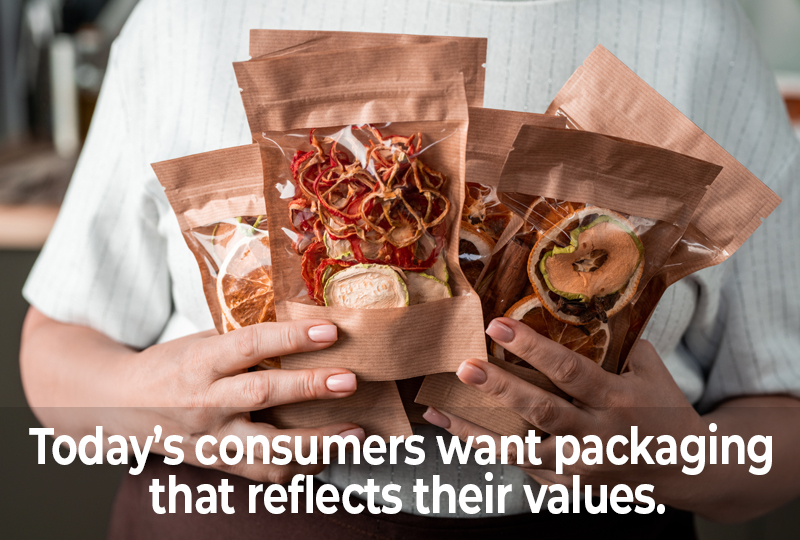Sustainable Snacks Packaging: Turning a Challenge Into a Competitive Advantage

North America’s organic snack market is growing fast, and so are expectations. Today’s consumers don’t just want healthier options like granola, trail mix, and plant-based bites. They want packaging that reflects their values: eco-friendly, sustainable, and responsibly made.
According to Shorr’s 2025 Sustainable Packaging Consumer Report, 54% of U.S. consumers have purchased products with sustainable packaging in the last six months, and 90% are more likely to buy from brands using eco-friendly materials. Younger shoppers are especially driven by these values, making sustainability a direct factor in loyalty and purchasing decisions.
Retailers and regulators are taking notice, enforcing stricter sustainability standards and recyclability requirements. For snack brands, this means sustainable packaging has moved beyond a trend; it’s now essential for shelf space, trust, and long-term growth.
But meeting these expectations isn’t easy. Packaging still has to protect fragile snacks, maintain freshness, and withstand shipping and handling. Even one weak seal or punctured pouch can mean wasted product and lost consumer confidence. In this fast-paced market, sustainable snack packaging isn’t just about doing good; it’s about staying competitive.
The Unique Challenges of Going Green
Switching to sustainable packaging disrupts every part of production. Here are the most common hurdles brands face when trying to deliver sustainable snack packaging at scale:
Fragile films and seal failures
Recyclable films demand precise sealing to keep snacks fresh. Even a tiny puncture or weak seal can lead to stale products, bloated bags, and retailer complaints. In a market where freshness drives loyalty, these failures directly damage a brand’s reputation.
Waste during production
Ironically, older machines often create more waste when running eco-friendly films. Misaligned cuts, bad seals, and frequent restarts send expensive recyclable material straight to landfills. This hidden waste drives up costs and undermines the very sustainability goals brands are trying to achieve.
Using extra film to compensate for equipment limits
Retailers expect a wide range of formats, from single-serve packs to bulk family-size bags and premium stand-up pouches. When machines can’t easily switch between these formats, brands often add extra layers of film or produce oversized bags to meet retailer display requirements. While this solves short-term needs, it increases material costs, shipping weight, and overall waste, directly conflicting with sustainability goals.
Labor challenges
High turnover and skill gaps make it difficult to maintain teams of specialized operators. Complex, outdated machines require constant manual adjustments, slowing production and increasing the risk of mistakes that lead to downtime and quality issues.
The DOY-Sigma: Built for Sustainable Snacks Packaging
Legacy machines weren’t designed for today’s eco-friendly films or fast-changing market demands. Snack brands need modern systems that combine precision, flexibility, and simplicity, and the Unified Flex DOY Sigma was built for exactly this purpose.
The DOY-Sigma is a compact, high-performance preformed pouch machine that automates the entire process: picking a bag, opening it, filling it, and sealing it. Despite its small footprint, just 48 inches long by 30 inches wide by 41 inches high, it delivers up to 20 bags per minute, depending on pouch size, product type, and film. It handles pouches 90 to 260 mm wide and 90 to 350 mm long, covering everything from single-serve snack packs to family-sized formats.
Precision for Delicate, Recyclable Films
Eco-friendly films require precise sealing to prevent leaks and maintain product integrity. The DOY Sigma is equipped with digital temperature controllers, vacuum sensors, and strong gripper fingers to ensure each pouch is securely sealed. This level of precision helps maintain snack freshness and reduce costly product recalls.
Flexibility to Reduce Overpackaging
The DOY Sigma supports a variety of packaging styles, including stand-up pouches, pillow bags, box pouches, doy rim style bags, and even stand-up pouches. Switching between formats is seamless, allowing brands to right-size packaging for each SKU and cut back on excess material. With this flexibility, companies can respond quickly to seasonal trends and evolving retailer demands.
Simple, Operator-Friendly Design
High turnover and labor shortages make intuitive systems essential. The DOY Sigma features a 7-inch touchscreen interface and built-in safety control sensors, designed for ease of use. It’s simple, user-friendly controls minimize training time and reduce reliance on specialized operators, ensuring consistent performance and smooth production even when staffing levels change.
Compact, Scalable Solution
With its compact footprint, the DOY Sigma integrates seamlessly into smaller facilities, co-packing operations, or production lines dedicated to new SKUs. It can be customized with optional accessories such as nitrogen flushing for extended freshness, hopper shaking for consistent product settling, dust collection nozzles for cleaner operations, and takeaway conveyors for improved efficiency. This adaptability makes it an ideal solution for producers looking to balance performance, space, and sustainability goals.
The Business Payoff: Sustainability Without Sacrifice
When sustainability is built into your packaging system, the benefits reach every corner of the business. Waste is reduced, production speeds stay consistent, and retailers gain confidence in your ability to deliver eco-friendly packaging. Most importantly, consumers see your commitment to the planet reflected in every package, strengthening loyalty and brand reputation.
For growing brands, the DOY Sigma provides an affordable way to experiment with sustainable materials and new SKUs without major capital investment. For established companies, it offers additional capacity and flexibility to expand product lines without disrupting core operations.
Final Thoughts: Sustainability as a Competitive Advantage
Sustainability in snack packaging isn’t just about being green; it’s about building systems that protect product quality, meet consumer expectations, and support business growth.
The DOY Sigma turns sustainable snacks packaging from a challenge into a strategic advantage. Handling fragile recyclable films with precision, reducing waste, and offering the flexibility to adapt to market changes helps brands grow while staying true to their environmental commitments.
Because in today’s market, packaging doesn’t just hold a product, it holds your brand’s values and your promise to consumers.